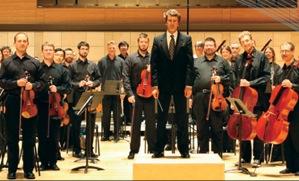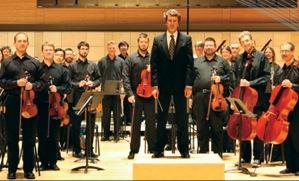Calvary Presbyterian Church in San Francisco hosted a concert on Sunday consisting of larger chamber works by Martinů, Vaughan Williams, Schubert, Monteverdi, and others. It was organized by members of the Bay Area Rainbow Symphony, a good community orchestra identifying with the LGBT community. The concert solicited donations for Larkin Street Youth Services, as well as the three-year-old orchestra’s own fund to purchase percussion instruments.

Chamber music as a social activity, of course, has a long history. Although it was more popular in the days before radio, television, and Angry Birds, amateur music making is very much alive. In Sunday’s concert, as can be expected with an ensemble that does not make a living playing music, the performances showed great variation in technical accomplishment: often very good, as in a lovely cover of the Adagio from Haydn’s “Emperor Quartet.” It would not be fair for me, however, to call shots. For marathon runners who train for months with no chance of winning (certain passages in the Schubert Octet come to mind), personal success can be simply getting through it. In such a situation, success is best measured by improvement and personal achievement.
Sunday’s concert took on interest for the wider musical community with the appearance of Brian Thorsett, a professional Bay Area tenor, who lent his talents to aid the concert’s beneficiaries, and with the premiere of three songs for tenor and string quartet by established San Francisco composer David Conte.
I first worked with Thorsett in 2005, and have truly been heartened to see his musical career expand over the past five years. He has always offered a healthy, clear, and beautiful tone, here better-sounding than ever. I was more impressed by his notable leap in musicality and versatility in style. If I had any argument with his performances, it was that he could afford to sound less pretty. Thorsett knows the rules; he should break them.
There is little demand and certainly less work in the professional world for vocal chamber music. American singers make their living meeting the expectations of huge opera houses, and they train to fit the demands of that industry. Thorsett subsumed certain consonants in the methods singers are taught in order to make music more legato. When the music was sad, he looked reliably and directorially sad. The songs from Schubert’s Die Winterreise, selections of which were heard here in a surprisingly attractive arrangement for voice and wind quintet by Joachim Linckelmann, are haunting and amazing. They are also Romantic — in the best sense of the word. To be romantic is to be intense, and with tension comes ugliness and distortion. What better opportunity could there have been than Sunday’s concert to be eccentric, to experiment, to make mistakes: to go mad?
Love’s Sorrows
I could understand why David Conte would save his Three Yeats Songs for voice and string quartet, written as early as 1983, for the drawer. The impressionistic and lyrical harmonies reminiscent of Barber and Vaughan Williams probably would not have gone over well in the new-music climate of the time. On Sunday, they sounded fresher, especially from Conte, who has made a specialty in recent years of producing ready-to-order choral commissions priced by the minute sounding both too short and too fat to my ears. Conte is best as a craftsman working with leaner textures, as shown by his best works, such as his chamber operas. Of the three songs, the first, “The Sorrow of Love,” with its rustling chords in the middle section and delicate form, was the strongest. I had the feeling that both it and the second song were reworked from piano accompaniments.
Conte’s work is not set in stone. Sounding fine on piano, a passage for diminished chords like one concluding his first Yeats song can prove on the violin to involve awkward string crossings that challenge even the most skilled player. The composer could change it ... or not. Musical performance is very much about the process of rehearsal, consideration of problems, agreeing on a cohesive and unified interpretation, and meeting challenges — a process that audiences can only glimpse. That these life-lessons are useful far beyond music performance is one reason that music instruction is in the curricula of better schools. Sunday’s players, who included a physicist, a pastry chef, a physician, a sculptor, a biologist, and an interior designer, among others, showed how it can also provide lifelong enjoyment and value.

